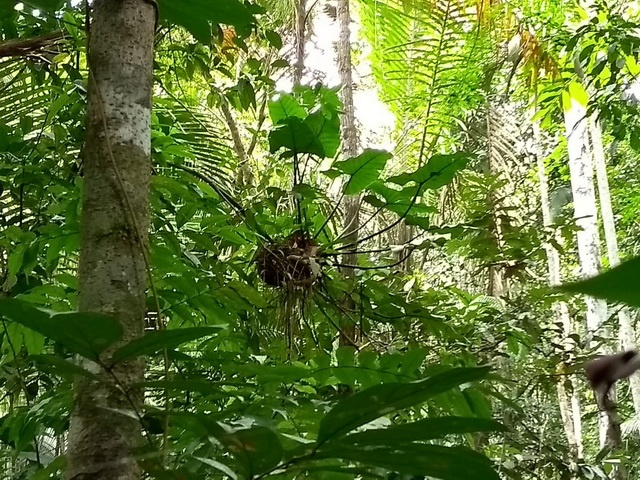Ants grow plants in tree nests
Some ants have ant gardens. In their nests, one or more plant species are flourishing. The ants are good gardeners, as a Brazilian research team shows: they select the plants carefully and protect them.
In the forests of the Amazon region, you can see hanging baskets, balls from which plants grow. They are the nests of ants that live in trees. These ant gardens benefit both parties. The plants belong to species that do not root in the soil but grow on tree branches (or in an arboreal ant’s nest), so-called epiphytes. They benefit because the ants disperse the seeds and fertilize the plants that germinate. The ants benefit because the plant roots strengthen the nest and make it rainproof.
Most of the hanging gardens in the Amazon region belong to two ant species that live together: Camponotus femoratus and Crematogaster levior. They share nests and foraging trails but keep their broods separated. A Brazilian research group describes how well this ant duo takes care of their gardens.
Division of tasks
The two species have divided the tasks. Crematogaster levior goes out to get food. The researchers think that it also is the one that, within a colony, takes the initiative to create a new nest; a colony contains on average 17 nests. Crematogaster levior workers are in the majority, especially in young nests; in initial nests, they are even the only ones.
But Camponotus femoratus is the stronger and more aggressive of the two. He constructs and defends the nests.
This species is also the one that collects seeds of the desired plants and puts them in the cardboard nest wall. He is picky: of the many epiphyte species that grow in South America, the ants only use a handful. Only one or two species are grown per nest.
The most common garden plant is Peperomia macrostachya. Probably, the ants are fond of it because, in addition to nectar glands, flowers and fruits, it also has oil glands. Oil is a hard-to-find part of the diet, so these glands are valuable. Among other plants used are Philodendron species.
Maintenance of ant gardens
The ants take good care of the plants. If a leaf is damaged, experiments showed, workers of Camponotus femoratus will gather there; they are triggered by volatile substances that are released upon damage. So, they arrive at places where herbivore insects are gnawing and they can chase them away. Especially damage to the precious Peperomia macrostachya provokes a rapid influx of many workers.
In addition, the ants prune ‘weeds’. The walls of an ants’ nest are an attractive growing place for many epiphytes because they are rich in nutrients. But the ants prevent the growth of unwanted plants that would compete with the garden plants. If the wrong seeds stick to the wall, the ants will remove them, and if the wrong plants germinate, they will cut the stem or leaves.
No wonder that the garden plants flourish and the hanging baskets look good.
Willy van Strien
Photo: Garden with Philodendron of the ant duo Camponotus femoratus and Crematogaster levior. ©Ricardo Eduardo Vicente
More about gardening ants: mini garden
Sources:
Pereira, A.A., I.V. da Silva & R.E. Vicente, 2021. Interaction between epiphytic chemical allelopathy and ant‑pruning determining the composition of Amazonian ant‑garden epiphytes. Arthropod-Plant Interactions, online April 9. Doi: 10.1007/s11829-021-09825-5
Dacquin, P., F. Degueldre & R.E. Vicente, 2021. Relative colony size of parabiotic species demonstrates inversion with growth. Insectes Sociaux, online January 2. Doi: 10.1007/s00040-020-00798-x
Vicente, R.E., W. Dáttilo & T.J. Izzo, 2014. Differential recruitment of Camponotus femoratus (Fabricius) ants in response to ant garden herbivory. Neotropical Entomology 43: 519-525. Doi: 10.1007/s13744-014-0245-6
